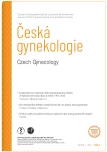Adenomyosis – its possible effect on endometrial function and receptivity
Authors:
Crha Karel 1; Ješeta Michal 1; Pilka Radovan 2; Ventruba Pavel 1; Žáková Jana 1; Vodička Jan 2; Crha Tomáš 1
Authors‘ workplace:
Gynekologicko-porodnická klinika LF MU a FN Brno
1; Porodnicko-gynekologická klinika LF UP a FN Olomouc
2
Published in:
Ceska Gynekol 2021; 86(3): 205-209
Category:
Review Article
doi:
https://doi.org/10.48095/cccg2021205
Overview
Objective: There have been many studies on adenomyosis, which can impair the quality of life of a woman. There are various kinds of opinions on the pathogenesis, diagnostics and treatment of adenomyosis. The goal of this article is to present the current knowledge of adenomyosis and its impact on the endometrial function and receptivity.
Methods: PubMed/Medline, Web of Sciences and Scopus were searched for the articles in English indexed until February 2021 with terms of: adenomyosis, endometrial receptivity, and infertility.
Results: Recent studies on angiogenesis and epithelial-mesenchymal transition in the endometrium bring new information on the ethiology and pathogenesis of adenomyosis. In clinical practice, the main diagnostic methods of adenomyosis include transvaginal ultrasound, magnetic resonance imaging or hysteroscopy, although the definitive confirmation is set by histopathological examination. The rules of #Enzian classification of endometriosis should be applied for the classification of adenomyosis. The treatment of adenomyosis should consider individual clinical presentation and reproductive plans of a patient and should be performed in centers for the treatment of endometriosis.
Conclusion: Adenomyosis affects endometrial vascularisation and epithelial-mesenchymal transition/mesenchymal-epithelial transition; thus, it can be the cause of irregular uterine bleeding or embryo implantation failure. The research and analysis of endometrial proteome could lead to the new ways of adenomyosis treatment.
Keywords:
adenomyosis – infertility – endometrial receptivity – proteome – pelvic pain
Sources
1. Younes G Tulandi T. Effects of adenomyosis on in vitro fertilization treatment outcomes: a meta-analysis. Fertil Steril 2017; 108 (3): 483 – –490. doi: 10.1016/j.fertnstert.2017.06.025.
2. Harmsen MJ, Wong CF, Mijatovic V et al. Role of angiogenesis in adenomyosis-associated abnormal uterine bleeding and subfertility: a systematic review. Hum Reprod Update 2019; 25 (5): 647–671. doi: 10.1093/humupd/dmz024.
3. Harada T, Khine YM, Kaponis A et al. The impact of idenomyosis on women’s fertility. Obstet Gynecol Surv 2016; 71 (9): 557–568. doi: 10.1097/OGX.0000000000000346.
4. Genc M, Genc B, Cengiz H. Adenomyosis and accompanying gynecological pathologies. Arch Gynecol Obstet 2015; 291 (4): 877–881. doi: 10.1007/s00404-014-3498-8.
5. Mullen RD, Behringer RR. Molecular genetics of Müllerian duct formation, regression and differentiation. Sex Dev 2014; 8 (5): 281–296. doi: 10.1159/000364935.
6. Szubert M, Koziróg E, Olszak O et al. Adenomyosis and infertility-review of medical and surgical approaches. Int J Environ Res Public Health 2021; 18 (3): 1235. doi: 10.3390/ijerph18031235.
7. Yen CF, Huang SJ, Lee CL et al. Molecular characteristics of the endometrium in uterine adenomyosis and its biochemical microenvironment. Reprod Sci 2017; 24 (10): 1346–1361. doi: 10.1177/1933719117691141.
8. Zhou C, Zhang T, Liu F et al. The differential expression of mRNAs and long noncoding RNAs between ectopic and eutopic endometria provides new insights into adenomyosis. Mol Biosyst 2016; 12 (2): 362–370. doi: 10.1039/c5mb00733j.
9. Juang CM, Chou P, Yen MS et al. Adenomyosis and risk of preterm delivery. BJOG 2007; 114 (2): 165–169. doi: 10.1111/j.1471-0528. 2006.01186.x.
10. Vercellini P, Consonni D, Dridi D et al. Uterine adenomyosis and in vitro fertilization outcome: a systematic reviewand meta-analysis. Hum Reprod 2014; 29 (5): 964–977. doi: 10.1093/humrep/deu041.
11. Van den Bosch T, de Bruijn AM, de Leeuw RA et al. A sonographic classification and reporting system for diagnosing adenomyosis. Ultrasound Obstet Gynecol 2019; 53 (5): 576–582. doi: 10.1002/uog.19096.
12. Dolná Z, Hašlík L, Frydrach J et al. Porovnání ultrazvuku a magnetické rezonance v diagnostice hluboké infiltrující endometriózy. Gyn Por 2020; 4 (3): 149–153.
13. Kovář P, Daňková Kučerová J, Dvořáčková J et al. Adenomyóza. Gyn Por 2020; 4 (3): 138–144.
14. Keckstein J, Saridogan E, Ulrich UA et al. The #Enzian classification: a comprehensive non-invasive and surgical description system for endometriosis. Acta Obstet Gynecol Scand 2021. Online ahead of print. doi: 10.1111/aogs.14 099.
15. Van den Bosch T, Dueholm M, Leone FP et al. Terms, definitions and measurements to describe sonographic features of myometrium and uterine masses: a consensus opinion from the Morphological Uterus Sonographic Assessment (MUSA) group. Ultrasound Obstet Gynecol 2015; 46 (3): 284–298. doi: 10.1002/uog.14806.
16. Owusu-Akyaw A, Krishnamoorthy K, Goldsmith LT et al. The role of mesenchymal-epithelial transition in endometrial function. Human Reprod Update 2019; 25 (1): 114–133. doi: 10.1093/humupd/dmy035.
17. Ješeta M, Crha T, Žáková J et al. Bisfenoly v patologii reprodukce. Ceska Gynekol 2019; 84 (2): 161–165.
18. Vodička J, Dvořan M, Smékalová K et al. Možnosti přípravy endometria ke kryotransferu. Ceska Gynekol 2018; 83 (1): 24–28.
19. Crha K, Ventruba P, Žáková J et al. The role of uterine microbiome and epithelial-mesenchymal transition in endometrial function. Med J Cell Biol 2019; 7 (3): 146–151. doi: 10.2478/acb-2019-0020.
20. Hudeček R, Ventruba P, Gazárková E et al. Konzervativní terapie klinických projevů endometriózy v reprodukční gynekologii. Bolest 2019; 22 (2): 60–69.
21. Papíková Z, Hudeček R, Ventruba P et al. Účinnost dienogestu v terapii klinických symptomů endometriózy rektovaginálního septa. Ceska Gynekol 2019; 84 (5): 331–336.
22. Ventruba P, Žáková J, Ješeta M et al. Současná témata reprodukční medicíny v České republice. Ceska Gynekol 2016; 81 (3): 234–240.
23. Zhang L, Rao F, Setzen R. High intensity focused ultrasound for the treatment of adenomyosis: selection criteria, efficacy, safety and fertility. Acta Obstet Gynecol Scand 2017; 96 (6): 707–714. doi: 10.1111/aogs.13159.
24. Huser M, Papíkova Z, Dziaková M et al. Radiofrekvenční ablace endometria – nová možnost konzervativní léčby silného menstruačního krvácení. Ceska Gynekol 2018; 83 (6): 418–423.
Labels
Paediatric gynaecology Gynaecology and obstetrics Reproduction medicineArticle was published in
Czech Gynaecology

2021 Issue 3
Most read in this issue
- Estetrol and the possibilities of its clinical use
- Adenomyosis – its possible effect on endometrial function and receptivity
- Hereditary antithrombin deficiency in pregnancy – severe thrombophilic disorder as a danger for mother and foetus
- Changes of the quality of sexual life following pelvic organ prolapse surgery
